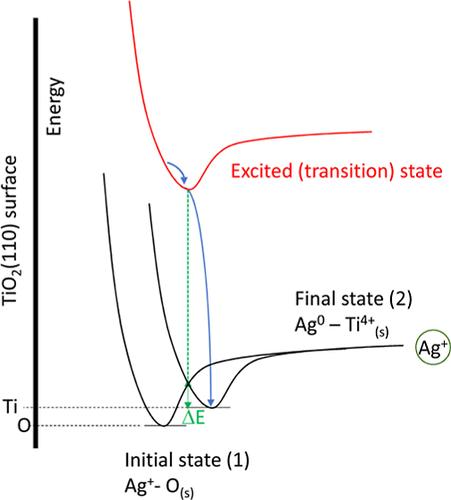当前位置:
X-MOL 学术
›
J. Phys. Chem. C
›
论文详情
Our official English website, www.x-mol.net, welcomes your feedback! (Note: you will need to create a separate account there.)
Electron Transfer between Metal Ions and Photoexcited Semiconductors
The Journal of Physical Chemistry C ( IF 3.3 ) Pub Date : 2024-06-20 , DOI: 10.1021/acs.jpcc.4c03105 K. Katsiev 1 , H. Idriss 2
The Journal of Physical Chemistry C ( IF 3.3 ) Pub Date : 2024-06-20 , DOI: 10.1021/acs.jpcc.4c03105 K. Katsiev 1 , H. Idriss 2
Affiliation

|
Electron transfer between metal ions and excited solid materials is central to many catalytic events in natural and synthetic systems. The interaction of metal ions, leading to their reduction, with the excited semiconductor is expected to decrease the lifetime of excited electrons and increase that of the holes. By conducting this reaction using a semiconductor single crystal [rutile TiO2 (110)] in the aqueous phase and the presence of different Ag+ concentrations, it was found that the initial signal of excited electrons increases and the signal related to holes decreases, which is the opposite of expectations. Results indicate that this is most likely related to the initial interaction, the adsorption process (surface OGS–Ag+; GS: ground state) that precedes the electron transfer reaction (Tiex3+–Ag metal; ex: excited state). Similar results are obtained for the Ce4+ interaction with the surface of TiO2(110).
中文翻译:

金属离子与光激发半导体之间的电子转移
金属离子和激发固体材料之间的电子转移是天然和合成系统中许多催化事件的核心。金属离子与受激半导体的相互作用导致其还原,预计会缩短受激电子的寿命并增加空穴的寿命。通过在水相中使用半导体单晶[金红石 TiO 2 (110)] 和不同 Ag + 浓度的存在进行该反应,发现初始信号受激电子增加,与空穴相关的信号减少,这与预期相反。结果表明,这很可能与电子转移反应 (Ti < b4> 3+ –Ag金属;例如:激发态)。 Ce 4+ 与 TiO 2 表面相互作用也得到了类似的结果 (110)。
更新日期:2024-06-20
中文翻译:

金属离子与光激发半导体之间的电子转移
金属离子和激发固体材料之间的电子转移是天然和合成系统中许多催化事件的核心。金属离子与受激半导体的相互作用导致其还原,预计会缩短受激电子的寿命并增加空穴的寿命。通过在水相中使用半导体单晶[金红石 TiO 2 (110)] 和不同 Ag + 浓度的存在进行该反应,发现初始信号受激电子增加,与空穴相关的信号减少,这与预期相反。结果表明,这很可能与电子转移反应 (Ti < b4> 3+ –Ag金属;例如:激发态)。 Ce 4+ 与 TiO 2 表面相互作用也得到了类似的结果 (110)。











































 京公网安备 11010802027423号
京公网安备 11010802027423号